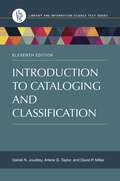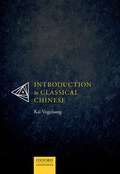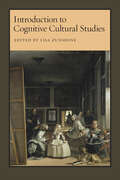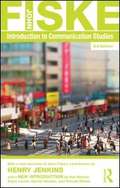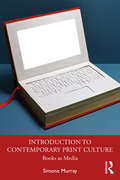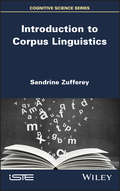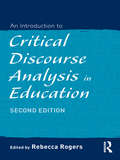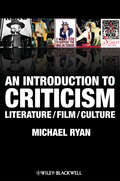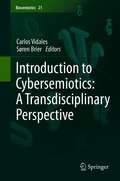- Table View
- List View
An Introduction to Book History (PDF)
by David Finkelstein Alistair McCleeryThis is a comprehensive introduction to books and print culture which examines the move from the spoken word to written texts, the book as commodity, the power and profile of readers, and the future of the book in an electronic age.
Introduction to Cataloging and Classification (Library and Information Science Text Series)
by Daniel N. Joudrey Arlene G. Taylor David P. MillerA new edition of this best-selling textbook reintroduces the topic of library cataloging from a fresh, modern perspective.Not many books merit an eleventh edition, but this popular text does. Newly updated, Introduction to Cataloging and Classification provides an introduction to descriptive cataloging based on contemporary standards, explaining the basic tenets to readers without previous experience, as well as to those who merely want a better understanding of the process as it exists today. The text opens with the foundations of cataloging, then moves to specific details and subject matter such as Functional Requirements for Bibliographic Records (FRBR), Functional Requirements for Authority Data (FRAD), the International Cataloging Principles (ICP), and RDA. Unlike other texts, the book doesn't presume a close familiarity with the MARC bibliographic or authorities formats; ALA's Anglo-American Cataloging Rules, 2nd Edition, revised (AACR2R); or the International Standard Bibliographic Description (ISBD). Subject access to library materials is covered in sufficient depth to make the reader comfortable with the principles and practices of subject cataloging and classification. In addition, the book introduces MARC, BIBFRAME, and other approaches used to communicate and display bibliographic data. Discussions of formatting, presentation, and administrative issues complete the book; questions useful for review and study appear at the end of each chapter.
Introduction to Cataloging and Classification (Library and Information Science Text Series)
by Daniel N. Joudrey Arlene G. Taylor David P. MillerA new edition of this best-selling textbook reintroduces the topic of library cataloging from a fresh, modern perspective.Not many books merit an eleventh edition, but this popular text does. Newly updated, Introduction to Cataloging and Classification provides an introduction to descriptive cataloging based on contemporary standards, explaining the basic tenets to readers without previous experience, as well as to those who merely want a better understanding of the process as it exists today. The text opens with the foundations of cataloging, then moves to specific details and subject matter such as Functional Requirements for Bibliographic Records (FRBR), Functional Requirements for Authority Data (FRAD), the International Cataloging Principles (ICP), and RDA. Unlike other texts, the book doesn't presume a close familiarity with the MARC bibliographic or authorities formats; ALA's Anglo-American Cataloging Rules, 2nd Edition, revised (AACR2R); or the International Standard Bibliographic Description (ISBD). Subject access to library materials is covered in sufficient depth to make the reader comfortable with the principles and practices of subject cataloging and classification. In addition, the book introduces MARC, BIBFRAME, and other approaches used to communicate and display bibliographic data. Discussions of formatting, presentation, and administrative issues complete the book; questions useful for review and study appear at the end of each chapter.
An Introduction to Child Language Development
by Susan H.Foster- CohenThis volume introduces the field of child language development studies, and presents hypotheses in an accessible, largely non-technical language, aiming to demonstrate the relationship between these hypotheses and interpretations of data. It makes the assumption that having a theory of language development is as important as having reliable data about what children say and understand, and it advocates a combination of both `rationalist' and more 'empiricist' traditions. In fact, the author overtly argues that different traditions provide different pieces of the picture, and that taking any single approach is unlikely to lead to productive understanding. Susan Foster-Cohen explores a range of issues, including the nature of prelinguistic communication and its possible relationship to linguistic development; early stages of language development and how they can be viewed in the light of later developments; the nature and role of children's experience with the language(s) around them; variations in language development due to both pathological and non-pathological differences between children, and (in the latter case) between the languages they learn; later oral language development; and literacy. The approach is distinctly psycholinguistic and linguistic rather than sociolinguistic, although there is significant treatment of issues which intersect with more sociolinguistic concerns (e.g. literacy, language play, and bilingualism). There are exercises and discussion questions throughout, designed to reinforce the ideas being presented, as well as to offer the student the opportunity to think beyond the text to ideas at the cutting edge of research.The accessible presentation of key issues will appeal to the intended undergraduate readership, and will be of interest to those taking courses in language development, linguistics, developmental psychology, educational linguistics, and speech pathology. The book will also serve as a useful introduction to students wishing to pursue post-graduate courses which deal with child language development.
An Introduction to Child Language Development
by Susan H.Foster- CohenThis volume introduces the field of child language development studies, and presents hypotheses in an accessible, largely non-technical language, aiming to demonstrate the relationship between these hypotheses and interpretations of data. It makes the assumption that having a theory of language development is as important as having reliable data about what children say and understand, and it advocates a combination of both `rationalist' and more 'empiricist' traditions. In fact, the author overtly argues that different traditions provide different pieces of the picture, and that taking any single approach is unlikely to lead to productive understanding. Susan Foster-Cohen explores a range of issues, including the nature of prelinguistic communication and its possible relationship to linguistic development; early stages of language development and how they can be viewed in the light of later developments; the nature and role of children's experience with the language(s) around them; variations in language development due to both pathological and non-pathological differences between children, and (in the latter case) between the languages they learn; later oral language development; and literacy. The approach is distinctly psycholinguistic and linguistic rather than sociolinguistic, although there is significant treatment of issues which intersect with more sociolinguistic concerns (e.g. literacy, language play, and bilingualism). There are exercises and discussion questions throughout, designed to reinforce the ideas being presented, as well as to offer the student the opportunity to think beyond the text to ideas at the cutting edge of research.The accessible presentation of key issues will appeal to the intended undergraduate readership, and will be of interest to those taking courses in language development, linguistics, developmental psychology, educational linguistics, and speech pathology. The book will also serve as a useful introduction to students wishing to pursue post-graduate courses which deal with child language development.
Introduction to Chinese Natural Language Processing (Synthesis Lectures on Human Language Technologies)
by Kam-Fai Wong Wenjie Li Ruifeng Xu Zheng-sheng ZhangThis book introduces Chinese language-processing issues and techniques to readers who already have a basic background in natural language processing (NLP). Since the major difference between Chinese and Western languages is at the word level, the book primarily focuses on Chinese morphological analysis and introduces the concept, structure, and interword semantics of Chinese words. The following topics are covered: a general introduction to Chinese NLP; Chinese characters, morphemes, and words and the characteristics of Chinese words that have to be considered in NLP applications; Chinese word segmentation; unknown word detection; word meaning and Chinese linguistic resources; interword semantics based on word collocation and NLP techniques for collocation extraction. Table of Contents: Introduction / Words in Chinese / Challenges in Chinese Morphological Processing / Chinese Word Segmentation / Unknown Word Identification / Word Meaning / Chinese Collocations / Automatic Chinese Collocation Extraction / Appendix / References / Author Biographies
Introduction to Classical Chinese
by Kai VogelsangThis textbook provides a comprehensive scholarly introduction to Classical Chinese and its texts. Classical Chinese is the language of Confucius and Mencius and their contemporaries, who wrote the seminal texts of Chinese philosophy more than 2,000 years ago. Although it was used as a living language for only a relatively short time, it was the foundation of Chinese education throughout the Imperial age, and formed the basis of a literary tradition that continues to the present day. This book offers students all the necessary tools to read, understand, and analyse Classical Chinese texts, including: step-by-step clearly illustrated descriptions of syntactic features; core vocabulary lists; introductions to relevant historical and cultural topics; selected readings from classical literature with original commentaries and in-depth explanations; introductions to dictionaries and other reference works on the study of ancient China; and a guide to philological methods used in the critical analysis of Classical Chinese texts. The extensive glossary provides phonological reconstructions, word classes, English translations, and citations to illustrate usage, while the up-to-date bibliography serves as a valuable starting point for further research.
Introduction to Cognitive Cultural Studies
by Lisa ZunshineDrawing on the explosion of academic and public interest in cognitive science in the past two decades, this volume features articles that combine literary and cultural analysis with insights from neuroscience, cognitive evolutionary psychology and anthropology, and cognitive linguistics. Lisa Zunshine’s introduction provides a broad overview of the field. The essays that follow are organized into four parts that explore developments in literary universals, cognitive historicism, cognitive narratology, and cognitive approaches in dialogue with other theoretical approaches, such as postcolonial studies, ecocriticism, aesthetics, and poststructuralism. Introduction to Cognitive Cultural Studies provides readers with grounding in several major areas of cognitive science, applies insights from cognitive science to cultural representations, and recognizes the cognitive approach’s commitment to seeking common ground with existing literary-theoretical paradigms. This book is ideal for graduate courses and seminars devoted to cognitive approaches to cultural studies and literary criticism.Contributors: Mary Thomas Crane, Nancy Easterlin, David Herman, Patrick Colm Hogan, Bruce McConachie, Alan Palmer, Alan Richardson, Ellen Spolsky, G. Gabrielle Starr, Blakey Vermeule, Lisa Zunshine
An Introduction to Cognitive Linguistics
by Friedrich Ungerer Hans-Jorg SchmidLearning About Language is an exciting and ambitious series of introductions to fundamental topics in language, linguistics and related areas. The books are designed for students of linguistics and those who are studying language as part of a wider course. Cognitive Linguistics explores the idea that language reflects our experience of the world. It shows that our ability to use language is closely related to other cognitive abilities such as categorization, perception, memory and attention allocation. Concepts and mental images expressed and evoked by linguistic means are linked by conceptual metaphors and metonymies and merged into more comprehensive cognitive and cultural models, frames or scenarios. It is only against this background that human communication makes sense. After 25 years of intensive research, cognitive-linguistic thinking now holds a firm place both in the wider linguistic and the cognitive-science communities.An Introduction to Cognitive Linguistics carefully explains the central concepts of categorizaÂtion, of prototype and gestalt perception, of basic level and conceptual hierarchies, of figure and ground, and of metaphor and metonymy, for which an innovative description is provided. It also brings together issues such as iconicity, lexical change, grammaticalization and language teaching that have profited considerably from being put on a cognitive basis.The second edition of this popular introduction provides a comprehensive and accessible up-to-date overview of Cognitive Linguistics: Clarifies the basic notions supported by new evidence and examples for their application in language learning Discusses major recent developments in the field: the increasing attention paid to metonymies, Construction Grammar, Conceptual Blending and its role in online-processing. Explores links with neighbouring fields like Relevance Theory Uses many diagrams and illustrations to make the theoretical argument more tangible Includes extended exercises Provides substantial updated suggestions for further reading.
An Introduction to Cognitive Linguistics
by Friedrich Ungerer Hans-Jorg SchmidLearning About Language is an exciting and ambitious series of introductions to fundamental topics in language, linguistics and related areas. The books are designed for students of linguistics and those who are studying language as part of a wider course. Cognitive Linguistics explores the idea that language reflects our experience of the world. It shows that our ability to use language is closely related to other cognitive abilities such as categorization, perception, memory and attention allocation. Concepts and mental images expressed and evoked by linguistic means are linked by conceptual metaphors and metonymies and merged into more comprehensive cognitive and cultural models, frames or scenarios. It is only against this background that human communication makes sense. After 25 years of intensive research, cognitive-linguistic thinking now holds a firm place both in the wider linguistic and the cognitive-science communities.An Introduction to Cognitive Linguistics carefully explains the central concepts of categorizaÂtion, of prototype and gestalt perception, of basic level and conceptual hierarchies, of figure and ground, and of metaphor and metonymy, for which an innovative description is provided. It also brings together issues such as iconicity, lexical change, grammaticalization and language teaching that have profited considerably from being put on a cognitive basis.The second edition of this popular introduction provides a comprehensive and accessible up-to-date overview of Cognitive Linguistics: Clarifies the basic notions supported by new evidence and examples for their application in language learning Discusses major recent developments in the field: the increasing attention paid to metonymies, Construction Grammar, Conceptual Blending and its role in online-processing. Explores links with neighbouring fields like Relevance Theory Uses many diagrams and illustrations to make the theoretical argument more tangible Includes extended exercises Provides substantial updated suggestions for further reading.
Introduction To Communication Studies
by John FiskeThis revised edition of a now classic text includes a new introduction by Henry Jenkins, explaining 'Why Fiske Still Matters' for today's students, followed by a discussion between former Fiske students Ron Becker, Elana Levine, Darrell Newton and Pamela Wilson on the theme of 'Structuralism and Semiotics, Fiske-Style'. Both underline the continuing relevance of this foundational text in communication studies. How can we study communication? What are the main theories and methods of approach? This classic text provides a lucid, accessible introduction to the main authorities in the field of communication studies, aimed at students coming to the subject for the first time. It outlines a range of methods of analysing examples of communication, and describes the theories underpinning them. Thus armed, the reader will be able to tease out the latent cultural meanings in such apparently simple communications as news photos or popular TV programmes, and to see them with new eyes.
Introduction to Contemporary Print Culture: Books as Media
by Simone MurrayIntroduction to Contemporary Print Culture examines the role of the book in the modern world. It considers the book’s deeply intertwined relationships with other media through ownership structures, copyright and adaptation, the constantly shifting roles of authors, publishers and readers in the digital ecosystem and the merging of print and digital technologies in contemporary understandings of the book object. Divided into three parts, the book first introduces students to various theories and methods for understanding print culture, demonstrating how the study of the book has grown out of longstanding academic disciplines. The second part surveys key sectors of the contemporary book world – from independent and alternative publishers to editors, booksellers, readers and libraries – focusing on topical debates. In the final part, digital technologies take centre stage as eBook regimes and mass-digitisation projects are examined for what they reveal about information power and access in the twenty-first century. This book provides a fascinating and informative introduction for students of all levels in publishing studies, book history, literature and English, media, communication and cultural studies, cultural sociology, librarianship and archival studies and digital humanities.
Introduction to Contemporary Print Culture: Books as Media
by Simone MurrayIntroduction to Contemporary Print Culture examines the role of the book in the modern world. It considers the book’s deeply intertwined relationships with other media through ownership structures, copyright and adaptation, the constantly shifting roles of authors, publishers and readers in the digital ecosystem and the merging of print and digital technologies in contemporary understandings of the book object. Divided into three parts, the book first introduces students to various theories and methods for understanding print culture, demonstrating how the study of the book has grown out of longstanding academic disciplines. The second part surveys key sectors of the contemporary book world – from independent and alternative publishers to editors, booksellers, readers and libraries – focusing on topical debates. In the final part, digital technologies take centre stage as eBook regimes and mass-digitisation projects are examined for what they reveal about information power and access in the twenty-first century. This book provides a fascinating and informative introduction for students of all levels in publishing studies, book history, literature and English, media, communication and cultural studies, cultural sociology, librarianship and archival studies and digital humanities.
An Introduction to Corpus Linguistics
by Graeme KennedyThe use of large, computerized bodies of text for linguistic analysis and description has emerged in recent years as one of the most significant and rapidly-developing fields of activity in the study of language. This book provides a comprehensive introduction and guide to Corpus Linguistics. All aspects of the field are explored, from the various types of electronic corpora that are available to instructions on how to design and compile a corpus. Graeme Kennedy surveys the development of corpora for use in linguistic research, looking back to the pre-electronic age as well as to the massive growth of computer corpora in the electronic age.
An Introduction to Corpus Linguistics
by Graeme KennedyThe use of large, computerized bodies of text for linguistic analysis and description has emerged in recent years as one of the most significant and rapidly-developing fields of activity in the study of language. This book provides a comprehensive introduction and guide to Corpus Linguistics. All aspects of the field are explored, from the various types of electronic corpora that are available to instructions on how to design and compile a corpus. Graeme Kennedy surveys the development of corpora for use in linguistic research, looking back to the pre-electronic age as well as to the massive growth of computer corpora in the electronic age.
Introduction to Corpus Linguistics
by Sandrine ZuffereyOver the past decades, the use of quantitative methods has become almost generalized in all domains of linguistics. However, using these methods requires a thorough understanding of the principles underlying them. Introduction to quantitative methods in linguistics aims at providing students with an up-to-date and accessible guide to both corpus linguistics and experimental linguistics. The objectives are to help students developing critical thinking about the way these methods are used in the literature and helping them to devise their own research projects using quantitative data analysis.
Introduction to Corpus Linguistics
by Sandrine ZuffereyOver the past decades, the use of quantitative methods has become almost generalized in all domains of linguistics. However, using these methods requires a thorough understanding of the principles underlying them. Introduction to quantitative methods in linguistics aims at providing students with an up-to-date and accessible guide to both corpus linguistics and experimental linguistics. The objectives are to help students developing critical thinking about the way these methods are used in the literature and helping them to devise their own research projects using quantitative data analysis.
Introduction to Court Interpreting (Translation Practices Explained)
by Holly MikkelsonAn Introduction to Court Interpreting has been carefully designed to be comprehensive, accessible and globally applicable. Starting with the history of the profession and covering the key topics from the role of the interpreter in the judiciary setting to ethical principles and techniques of interpreting, this text has been thoroughly revised. The new material covers: remote interpreting and police interpreting; role-playing scenarios including the Postville case of 2008; updated and expanded resources. In addition, the extensive practical exercises and suggestions for further reading help to ensure this remains the essential introductory textbook for all courses on court interpreting
Introduction to Court Interpreting (Translation Practices Explained)
by Holly MikkelsonAn Introduction to Court Interpreting has been carefully designed to be comprehensive, accessible and globally applicable. Starting with the history of the profession and covering the key topics from the role of the interpreter in the judiciary setting to ethical principles and techniques of interpreting, this text has been thoroughly revised. The new material covers: remote interpreting and police interpreting; role-playing scenarios including the Postville case of 2008; updated and expanded resources. In addition, the extensive practical exercises and suggestions for further reading help to ensure this remains the essential introductory textbook for all courses on court interpreting
An Introduction to Critical Discourse Analysis in Education
by Rebecca RogersAccessible yet theoretically rich, this landmark text introduces key concepts and issues in critical discourse analysis and situates these within the field of educational research. The book invites readers to consider the theories and methods of three major traditions in critical discourse studies – discourse analysis, critical discourse analysis, and multimodal discourse analysis -- through the empirical work of leading scholars in the field. Beyond providing a useful overview, it contextualizes CDA in a wide range of learning environments and identifies how CDA can shed new insights on learning and social change. Detailed analytic procedures are included – to demystify the process of conducting CDA, to invite conversations about issues of trustworthiness of interpretations and their value to educational contexts, and to encourage researchers to build on the scholarship in critical discourse studies. This edition features a new structure; a touchstone chapter in each section by a recognized expert (Gee, Fairclough, Kress); and a stronger international focus on both theories and methods. NEW! Companion Website with Chapter Extensions; Interviews; Bibliographies; and Resources for Teaching Critical Discourse Analysis.
An Introduction to Critical Discourse Analysis in Education
by Rebecca RogersAccessible yet theoretically rich, this landmark text introduces key concepts and issues in critical discourse analysis and situates these within the field of educational research. The book invites readers to consider the theories and methods of three major traditions in critical discourse studies – discourse analysis, critical discourse analysis, and multimodal discourse analysis -- through the empirical work of leading scholars in the field. Beyond providing a useful overview, it contextualizes CDA in a wide range of learning environments and identifies how CDA can shed new insights on learning and social change. Detailed analytic procedures are included – to demystify the process of conducting CDA, to invite conversations about issues of trustworthiness of interpretations and their value to educational contexts, and to encourage researchers to build on the scholarship in critical discourse studies. This edition features a new structure; a touchstone chapter in each section by a recognized expert (Gee, Fairclough, Kress); and a stronger international focus on both theories and methods. NEW! Companion Website with Chapter Extensions; Interviews; Bibliographies; and Resources for Teaching Critical Discourse Analysis.
An Introduction to Criticism: Literature - Film - Culture (Coursesmart Ser.)
by Michael RyanAn accessible and thorough introduction to literary theory and contemporary critical practice, this book is an essential resource for beginning students of literary criticism. Covers traditional approaches such as formalism and structuralism, as well as more recent developments in criticism such as evolutionary theory, cognitive studies, ethical criticism, and ecocriticism Offers explanations of key works and major ideas in literary criticism and suggests key elements to look for in a literary text Also applies critical approaches to various examples from film studies Helps students to build a critical framework and write analytically
An Introduction to Criticism: Literature - Film - Culture
by Michael RyanAn accessible and thorough introduction to literary theory and contemporary critical practice, this book is an essential resource for beginning students of literary criticism. Covers traditional approaches such as formalism and structuralism, as well as more recent developments in criticism such as evolutionary theory, cognitive studies, ethical criticism, and ecocriticism Offers explanations of key works and major ideas in literary criticism and suggests key elements to look for in a literary text Also applies critical approaches to various examples from film studies Helps students to build a critical framework and write analytically
Introduction To Cryptography With Mathematical Foundations And Computer Implementations (Discrete Mathematics And Its Applications Ser.)
by Alexander StanoyevitchFrom the exciting history of its development in ancient times to the present day, Introduction to Cryptography with Mathematical Foundations and Computer Implementations provides a focused tour of the central concepts of cryptography. Rather than present an encyclopedic treatment of topics in cryptography, it delineates cryptographic concepts in chronological order, developing the mathematics as needed. Written in an engaging yet rigorous style, each chapter introduces important concepts with clear definitions and theorems. Numerous examples explain key points while figures and tables help illustrate more difficult or subtle concepts. Each chapter is punctuated with "Exercises for the Reader;" complete solutions for these are included in an appendix. Carefully crafted exercise sets are also provided at the end of each chapter, and detailed solutions to most odd-numbered exercises can be found in a designated appendix. The computer implementation section at the end of every chapter guides students through the process of writing their own programs. A supporting website provides an extensive set of sample programs as well as downloadable platform-independent applet pages for some core programs and algorithms. As the reliance on cryptography by business, government, and industry continues and new technologies for transferring data become available, cryptography plays a permanent, important role in day-to-day operations. This self-contained sophomore-level text traces the evolution of the field, from its origins through present-day cryptosystems, including public key cryptography and elliptic curve cryptography.
Introduction to Cybersemiotics: A Transdisciplinary Perspective (Biosemiotics #21)
by Carlos Vidales Søren BrierThis book traces the origins and evolution of cybersemiotics, beginning with the integration of semiotics into the theoretical framework of cybernetics and information theory. The book opens with chapters that situate the roots of cybersemiotics in Peircean semiotics, describe the advent of the Information Age and cybernetics, and lay out the proposition that notions of system, communication, self-reference, information, meaning, form, autopoiesis, and self-control are of equal topical interest to semiotics and systems theory. Subsequent chapters introduce a cybersemiotic viewpoint on the capacity of arts and other practices for knowing. This suggests pathways for developing Practice as Research and practice-led research, and prompts the reader to view this new configuration in cybersemiotic terms. Other contributors discuss cultural and perceptual shifts that lead to interaction with hybrid environments such as Alexa. The relationship of storytelling and cybersemiotics is covered at chapter length, and another chapter describes an individual-collectivity dialectics, in which the latter (Commind) constrains the former (interactants), but the former fuels the latter. The concluding chapter begins with the observation that digital technologies have infiltrated every corner of the metropolis - homes, workplaces, and places of leisure - to the extent that cities and bodies have transformed into interconnected interfaces. The book challenges the reader to participate in a broader discussion of the potential, limitations, alternatives, and criticisms of cybersemiotics.

